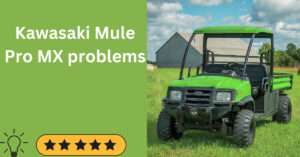Are you tired of your Cub Cadet ZT1 50 giving you a hard time when you’re just trying to keep your lawn in tip-top shape? Well, you’re not alone! Many homeowners face various problems with their beloved lawn mowers, and it can be frustrating. But fear not, as we’re here to help you navigate through these common Cub Cadet ZT1 50 problems issues and get your trusty mower back on track.
In this article, we’ll dive into some of the most prevalent problems of Cub Cadet ZT1 50 and provide easy-to-follow solutions. Let’s roll up our sleeves and get your mower humming again!
The most common cub cadet zt1 50 problems are Engine Starting Issues, Uneven Cutting, Excessive Vibration, Transmission Problems, Steering Difficulties, Loss of Power, Blade Engagement Troubles, Battery Problems, Fuel-Related Issues, Hydraulic Fluid Leaks, Deck Belt Slippage and Strange Noises.
12 Cub Cadet ZT1 50 problems
Here we discuss the most common cub cadet zt1 problems that most owner face and tell the easy solutions.
1. Engine Starting Issues
One of the most frustrating problems you may encounter with your Cub Cadet ZT1 50 is difficulty starting the engine. This can be caused by a variety of factors, including a dead battery, a faulty ignition switch, or a clogged fuel filter.
Possible Causes:
- Empty Fuel Tank: Ensure there is enough fuel in the tank.
- Dead Battery: Check the battery’s charge and connections.
- Faulty Spark Plug: Inspect and replace if necessary.
- Clogged Air Filter: A dirty air filter can prevent air from entering the engine.
Solution:
- Fill the fuel tank if it’s empty.
- Charge or replace the battery if needed.
- Replace the spark plug if it’s old or damaged.
- Clean or replace the air filter if it’s clogged.
2. Uneven Cutting
If your mower is leaving patches of uncut grass or cutting unevenly, it can impact the overall appearance of your lawn.
Possible Causes:
- Dull Blades: Worn-out blades can lead to uneven cutting.
- Uneven Tire Pressure: Check and adjust the tire pressure.
- Deck Misalignment: Ensure the mower deck is level.
Solution:
- Sharpen or replace the blades regularly.
- Maintain even tire pressure on all four tires.
- Level the mower deck following the manufacturer’s instructions.
3. Excessive Vibration
In cub cadet zt1 50 problems Excessive vibration is the most common problem, and it occurs during operation can be both annoying and a sign of potential issues.
Possible Causes:
- Loose or Damaged Blades: Check for loose or damaged blades.
- Worn Deck Belt: A worn-out belt can cause vibrations.
- Uneven Tire Pressure: Ensure all tires have the correct pressure.
Solution:
- Tighten or replace loose or damaged blades.
- Replace the deck belt if it’s worn.
- Maintain even tire pressure.
4. Transmission Problems
This is one of the most common Cub Cadet ZT1 50 problems that the owner face beacuse issues with the mower’s transmission can impede its performance and maneuverability.
Problem 1: Difficulty in Shifting Gears or Gears Slipping
Possible Causes:
- Low or Dirty Transmission Fluid: Low or contaminated transmission fluid can affect gear shifting.
- Worn or Damaged Drive Belt: A worn or damaged drive belt may not provide proper traction.
- Clutch or Control Lever Issues: Problems with the clutch or control lever can lead to gear shifting difficulties.
Solution:
- Check and top up the transmission fluid to the recommended level with the correct type of fluid.
- Inspect the drive belt for wear or damage and replace it if necessary.
- Examine the clutch and control lever mechanism for any issues and repair or replace as needed.
Problem 2: Loss of Drive Power
Possible Causes:
- Low Transmission Fluid: Insufficient fluid can result in a loss of drive power.
- Damaged or Worn Hydraulic Components: Hydraulic system issues can affect power transmission.
- Drive Belt Problems: A worn or loose drive belt can lead to reduced power.
Solution:
- Check and refill the transmission fluid to the proper level with the recommended fluid.
- Inspect the hydraulic components for damage or wear and replace as needed.
- Examine the drive belt for wear or tension issues and replace or adjust it accordingly.
Problem 3: Strange Noises or Grinding Sounds
Possible Causes:
- Low Transmission Fluid: Inadequate fluid can lead to noise in the transmission.
- Worn Gears or Bearings: Over time, gears and bearings may wear out, causing noise.
- Contaminated Transmission Fluid: Dirty or contaminated fluid can produce grinding sounds.
Solution:
- Check and top up the transmission fluid with clean, recommended fluid.
- Inspect the gears and bearings for wear and replace as necessary.
- Replace the transmission fluid if it’s contaminated or old.
Problem 4: Slow Response or Delayed Movement
Possible Causes:
- Low Transmission Fluid: Low fluid levels can cause sluggish response.
- Clogged Hydraulic Filter: A clogged filter can impede hydraulic fluid flow.
- Air in the Hydraulic System: Air bubbles in the hydraulic system can slow down response times.
Solution:
- Ensure the transmission fluid is at the proper level.
- Replace the hydraulic filter if it’s clogged.
- Bleed the hydraulic system to remove any air pockets if needed.
5. Steering Difficulties
If you find it hard to steer your Cub Cadet ZT1 50, it can make mowing a cumbersome task.
Problem 1: Hard to Turn the Steering Wheel
Possible Causes:
- Low or Contaminated Hydraulic Fluid: Inadequate or dirty hydraulic fluid can make steering difficult.
- Worn Steering Components: Wear and tear on steering components can lead to stiffness.
- Air in the Hydraulic System: Air pockets in the hydraulic system can affect steering.
Solution:
- Check and top up the hydraulic fluid to the recommended level with the correct type of fluid.
- Inspect the steering components, such as tie rods and linkage, for wear or damage and replace them as necessary.
- Bleed the hydraulic system to remove air bubbles if needed.
Problem 2: Uneven or Jerky Steering
Possible Causes:
- Uneven Tire Pressure: Inconsistent tire pressure can cause uneven steering.
- Worn or Damaged Tires: Tires in poor condition can result in jerky steering.
- Misaligned Wheels: Wheel misalignment can lead to uneven steering.
Solution:
- Maintain consistent tire pressure on all four tires.
- Inspect the tires for wear and damage, replacing them as needed.
- Check and adjust the wheel alignment according to the manufacturer’s instructions.
Problem 3: Steering Wheel Play or Excessive Movement
Possible Causes:
- Worn Steering Gear or Linkage: Wear in steering components can result in play.
- Loose Bolts or Nuts: Loose fasteners can lead to excessive steering wheel movement.
- Damaged Steering Column: A damaged steering column may cause play.
Solution:
- Inspect the steering gear and linkage for wear and replace as necessary.
- Tighten all bolts and nuts related to the steering system.
- If the steering column is damaged, it may need to be replaced.
6. Loss of Power
It is a major cub cadet zt1 50 problem because a noticeable loss of power can be attributed to several factors, including a dirty air filter, worn spark plugs, or a malfunctioning carburetor.
Possible Causes:
- Dirty Air Filter: A clogged air filter restricts airflow to the engine, reducing power.
- Old Spark Plug: A worn-out spark plug can lead to poor ignition and decreased power.
- Fuel Issues: Problems with fuel quality or the fuel system can result in power loss.
- Engine Overheating: Excessive engine heat can lead to power reduction.
- Clogged Muffler or Exhaust: A blocked muffler or exhaust system can restrict airflow and reduce power.
- Worn or Damaged Engine Components: Worn or damaged engine parts can affect power output.
Solution:
- Clean or Replace the Air Filter: Regularly inspect and clean or replace the air filter as needed to ensure proper airflow.
- Replace the Spark Plug: Change the spark plug at the recommended intervals or if it’s worn or fouled.
- Check Fuel Quality: Use clean, fresh fuel and ensure the fuel system is free from debris or blockages.
- Monitor Engine Temperature: Avoid overloading the engine or operating in extremely hot conditions, which can cause overheating.
- Inspect the Muffler and Exhaust System: Remove any obstructions from the muffler or exhaust system to improve airflow.
- Engine Component Inspection: If power loss persists, have a professional mechanic inspect the engine for worn or damaged components and address any necessary repairs.
7. Blade Engagement Troubles
Problems with engaging the mower blades can hinder your ability to cut grass effectively.
Possible Causes:
- Faulty PTO (Power Take-Off) Switch: The PTO switch may be malfunctioning or damaged.
- Worn PTO Clutch: The PTO clutch, which engages the blades, can wear out over time.
- Broken or Loose Drive Belt: A damaged or loose drive belt can prevent blade engagement.
- Faulty Wiring or Electrical Connections: Damaged wiring or poor electrical connections can disrupt the blade engagement circuit.
- Safety Interlock Issues: Problems with safety switches or interlock systems can prevent blade engagement.
- Blade Obstructions: Debris or obstructions around the mower deck can impede blade movement.
Solution:
- Inspect and Replace PTO Switch: Check the PTO switch for proper function. If it’s not working correctly, replace it.
- Examine and Replace PTO Clutch: Inspect the PTO clutch for wear or damage. If it’s worn out, replace it with a new one.
- Check and Replace Drive Belt: Inspect the drive belt for damage or looseness. Replace it if necessary, and ensure proper tension.
- Inspect Wiring and Connections: Carefully examine the wiring and electrical connections in the blade engagement circuit. Repair or replace any damaged components.
- Verify Safety Interlocks: Ensure all safety switches and interlock systems are functioning as they should. Replace any faulty components.
- Remove Blade Obstructions: Clear any debris or obstructions around the mower deck and blades to allow for smooth engagement.
8. Battery Problems
It is also a major cub cadet zt1 50 problems because a dead or weak battery can leave you stranded mid-mow.
Possible Causes:
- Dead Battery: The battery may be discharged or no longer hold a charge.
- Corroded Battery Terminals: Corrosion on the battery terminals can disrupt the electrical connection.
- Faulty Charging System: Issues with the mower’s charging system may prevent the battery from recharging.
- Parasitic Drain: Certain electrical components may draw power even when the mower is not in use, causing the battery to drain.
- Improper Battery Maintenance: Lack of proper maintenance, such as checking the water level in a lead-acid battery, can lead to battery problems.
Solution:
- Charge or Replace the Battery: If the battery is dead, recharge it using a battery charger, or replace it with a new one if it no longer holds a charge.
- Clean Battery Terminals: Remove corrosion from the battery terminals using a wire brush and a mixture of baking soda and water. Ensure a clean, tight connection.
- Inspect the Charging System: Check the charging system components, including the alternator and voltage regulator, for any issues. Replace any faulty parts.
- Identify Parasitic Drain: Use a multimeter to identify any electrical components that are drawing power when the mower is off. Address and repair the issue causing the drain.
- Follow Battery Maintenance Guidelines: If your mower has a lead-acid battery, maintain it according to the manufacturer’s recommendations, including checking water levels if applicable and keeping it clean.
9. Fuel-Related Issues
If the mower sputters or stalls during operation, it could be due to fuel-related problems.
Possible Causes:
- Stale or Contaminated Fuel: Old or contaminated fuel can cause engine problems.
- Clogged Fuel Filter: A clogged fuel filter restricts fuel flow to the engine.
- Fuel Line Blockage: Blockages in the fuel lines can prevent proper fuel delivery.
- Dirty Carburetor: A dirty or clogged carburetor can lead to poor engine performance.
- Water in the Fuel: Water in the fuel can disrupt combustion and cause engine issues.
- Incorrect Fuel Type: Using the wrong type of fuel can lead to problems.
Solution:
- Use Fresh, Clean Fuel: Always use fresh, high-quality fuel that meets the manufacturer’s recommendations. Avoid using fuel that has been sitting for an extended period.
- Replace the Fuel Filter: Regularly replace the fuel filter as part of your mower’s maintenance schedule to ensure unrestricted fuel flow.
- Check and Clean Fuel Lines: Inspect the fuel lines for blockages or damage and clean or replace them as needed.
- Clean the Carburetor: If the carburetor is dirty or clogged, clean it according to the manufacturer’s instructions.
- Drain Water from the Fuel System: If you suspect water in the fuel, drain the fuel tank and lines, and replace with fresh fuel.
- Use the Correct Fuel Type: Ensure you are using the correct type of fuel recommended by the manufacturer (usually gasoline) and avoid mixing oil with the fuel unless specified for a 2-stroke engine.
10. Hydraulic Fluid Leaks
Leaking hydraulic fluid can lead to reduced mower performance and potential damage.
Possible Causes:
- Damaged Hydraulic Hoses: Cracked or damaged hydraulic hoses can leak fluid.
- Loose or Faulty Fittings: Loose or faulty hydraulic fittings and connections can result in leaks.
- Worn Seals or O-Rings: Over time, seals and O-rings in the hydraulic system can degrade and cause leaks.
- Hydraulic Component Damage: Damage to hydraulic components such as pumps or cylinders can lead to fluid leaks.
- Improper Hydraulic Fluid Level: Overfilling the hydraulic reservoir can cause excess pressure and leaks.
Solution:
- Inspect Hydraulic Hoses: Carefully inspect all hydraulic hoses for cracks, abrasions, or damage. Replace any damaged hoses with new ones.
- Check Fittings and Connections: Tighten loose fittings and connections. Replace any faulty fittings or O-rings.
- Examine Seals: Inspect hydraulic seals for wear or damage. Replace any worn or damaged seals with compatible replacements.
- Assess Hydraulic Component Condition: If you suspect damage to hydraulic components like pumps or cylinders, have them professionally inspected and repaired or replaced as needed.
- Maintain Proper Fluid Level: Ensure the hydraulic fluid is at the correct level, as per the manufacturer’s recommendations. Avoid overfilling, which can cause excess pressure and leaks.
11. Deck Belt Slippage
Deck belt slippage can result in uneven cutting and poor performance.
Possible Causes:
- Worn or Loose Deck Belt: A worn-out or improperly tensioned deck belt can slip.
- Belt Misalignment: The deck belt may not be properly aligned on the pulleys.
- Damaged or Misaligned Pulleys: Damaged or misaligned pulleys can cause belt slippage.
- Excessive Debris: Accumulated debris or grass clippings under the mower deck can interfere with the belt’s operation.
- Weak Tension Spring: The tension spring that keeps the belt tight may be weak or damaged.
Solution:
- Inspect and Replace the Deck Belt: Examine the deck belt for wear and replace it if it’s worn or damaged. Ensure it’s properly tensioned according to the manufacturer’s specifications.
- Check Belt Alignment: Make sure the deck belt is properly aligned on all the pulleys. Adjust the belt if it has shifted out of place.
- Examine Pulleys: Inspect the pulleys for damage, misalignment, or wear. Replace any damaged pulleys and ensure they are properly aligned.
- Clean Under the Mower Deck: Regularly clean the area under the mower deck to prevent debris buildup, which can interfere with belt operation.
- Check Tension Spring: Inspect the tension spring that keeps the belt tight. Replace it if it’s weak or damaged to maintain proper tension.
12. Strange Noises
Unusual noises coming from your mower may indicate underlying issues.
Possible Causes:
- Squealing or Screeching: High-pitched squealing or screeching noises may indicate issues with belts, pulleys, or the blade engagement system.
- Rattling or Clanking: Rattling or clanking noises can be a result of loose or damaged components, such as loose hardware or damaged blades.
- Grinding or Whirring: Grinding or whirring sounds could be due to problems with the engine, transmission, or spindle bearings.
- Popping or Clicking: Popping or clicking noises may be related to loose or worn components, particularly in the steering or suspension system.
- Hissing or Whistling: Hissing or whistling sounds may signal a hydraulic fluid leak or a damaged hydraulic hose.
- Backfiring: Backfiring noises from the engine typically indicate a fuel or ignition system issue.
Solution:
- Inspect and Replace Belts and Pulleys: Examine the belts and pulleys for wear, damage, or misalignment. Replace any worn or damaged components and ensure proper tension.
- Tighten Loose Hardware: Check for loose nuts, bolts, and other hardware throughout the mower. Tighten them as needed.
- Inspect Blades: Inspect the mower blades for damage or excessive wear. Replace blades that are bent or damaged.
- Check Engine and Transmission: If you hear grinding or whirring noises, have a professional mechanic inspect the engine, transmission, and spindle bearings for issues.
- Inspect Steering and Suspension: For popping or clicking noises, examine the steering and suspension components for loose or worn parts. Replace or tighten as needed.
- Check for Hydraulic Leaks: For hissing or whistling sounds, inspect the hydraulic system for leaks and damaged hoses. Replace or repair any affected components.
- Address Fuel or Ignition Issues: If you hear backfiring noises, investigate the fuel and ignition system for problems and have them repaired or adjusted by a professional.
Conclusion About Cub Cadet zt1 50 Problems:
In conclusion, owning a Cub Cadet ZT1 50 riding mower comes with its share of challenges, but most problems can be resolved with proper maintenance and timely troubleshooting. By following the solutions provided in this article, you can keep your mower running smoothly and enjoy a well-manicured lawn all year round.
FAQs about cub cadet zt1 50 problems:
How often should I sharpen the mower blades?
Blades should be sharpened at least once a season, but more frequent sharpening may be necessary depending on usage.
What type of fuel should I use in my Cub Cadet ZT1 50?
Use only unleaded gasoline with an octane rating of 87 or higher.
Can I store my mower outdoors during winter?
It’s not recommended. Store your mower in a dry, sheltered area to prevent damage from the elements.
How do I check the transmission fluid level?
Consult your owner’s manual for specific instructions, as it may vary depending on the model.
Why is my mower vibrating excessively?
Excessive vibration can be caused by loose or damaged components. Inspect and tighten all nuts and bolts, and replace damaged parts as needed.
Remember that regular maintenance and addressing problems promptly will ensure your Cub Cadet ZT1 50 remains a reliable and efficient tool for your lawn care needs.








